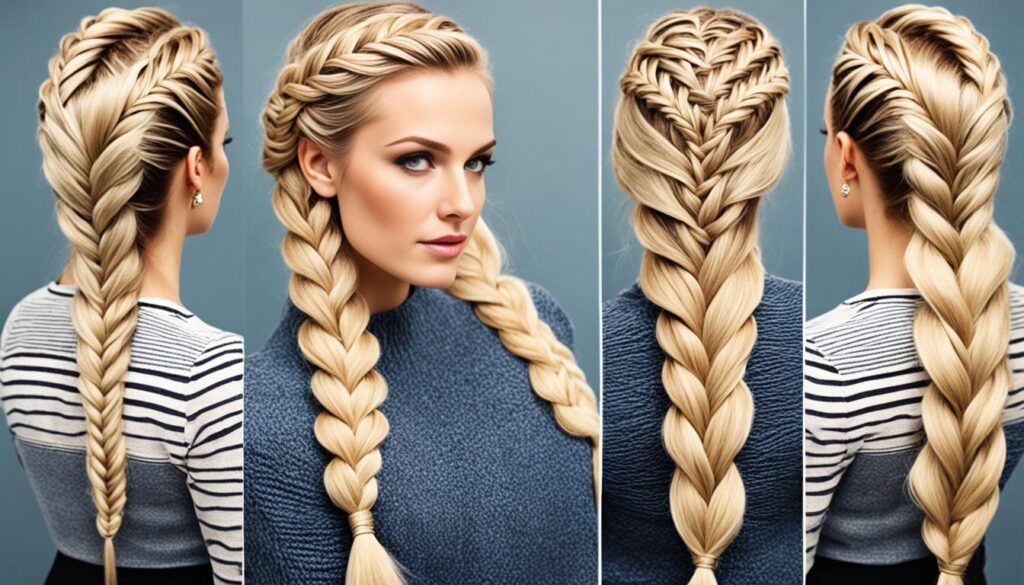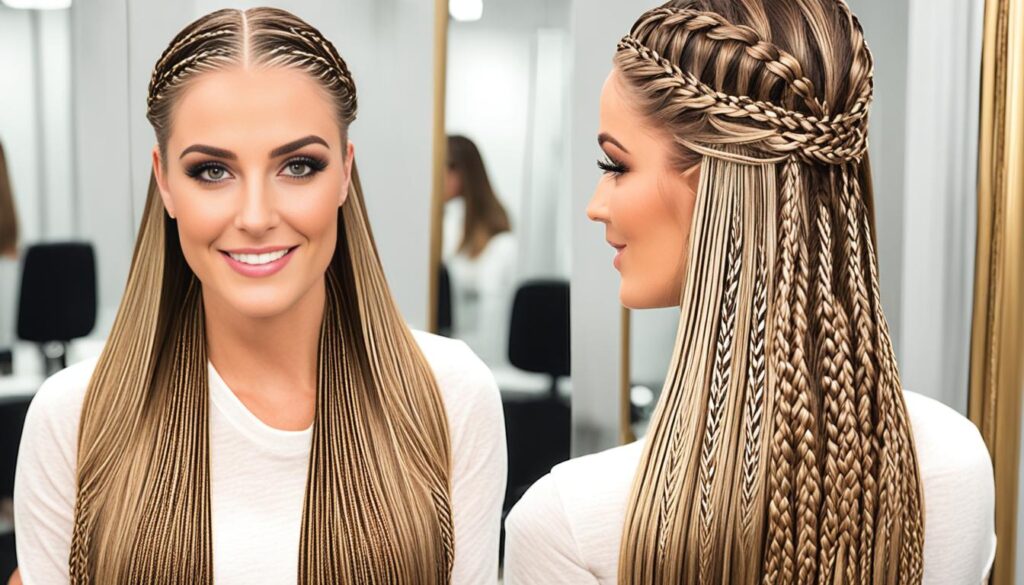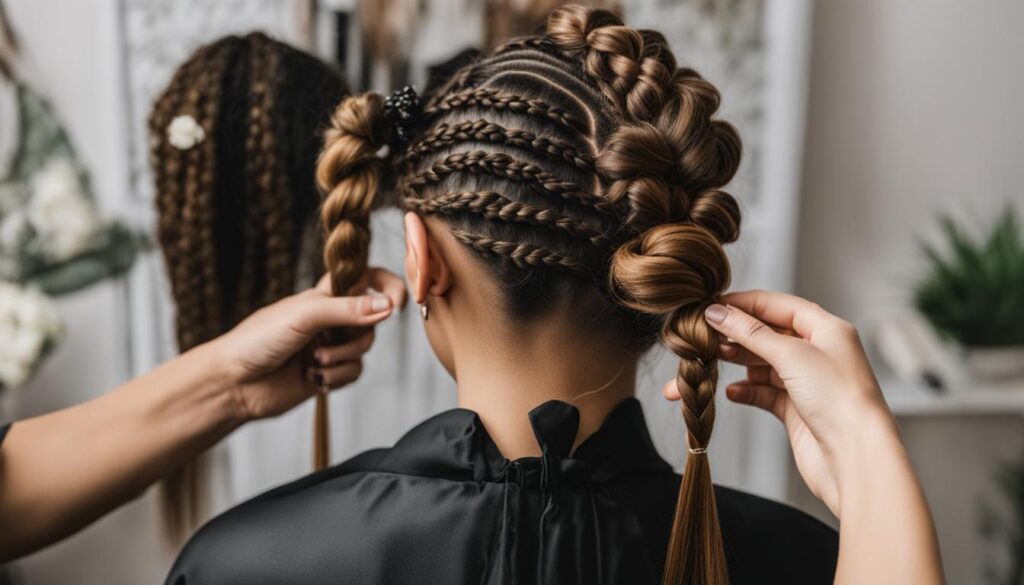
When it comes to styling your hair, you might find yourself using the terms “plait” and “braid” interchangeably. But have you ever wondered if there’s a difference between the two? Are plaiting and braiding the same technique, or do they involve distinct methods? In this article, we will delve into the world of hair plaiting and braiding, exploring the differences, techniques, and styles associated with each. Get ready to unravel the mysteries and discover the art of creating stunning hairstyles!
Key Takeaways:
- Plaits and braids are two different techniques used for styling hair.
- Plaits typically involve three strands of hair, while braids can incorporate any number of strands.
- The technique used for plaiting involves weaving the outer strands over the middle strand, creating a symmetrical pattern.
- Braiding can involve more complex techniques and designs, such as Dutch braids and cornrows.
- Understanding the differences between plaits and braids can help you choose the right technique for your desired look.
The Origins of Plaits and Braids
Plaits and braids have a rich history that dates back thousands of years. Plaits originated in ancient Egypt and were used to create intricate hairstyles for both men and women. Braids, on the other hand, have been used for over 30,000 years and can be traced back to the Venus of Willendorf figurine found in modern-day Austria. Both plaits and braids evolved across different cultures and regions, each putting its unique spin on the art of hair styling.
Understanding the Differences Between Plaits and Braids
The primary difference between plaits and braids lies in the number of strands used. Plaits typically involve three sections of hair, while braids can incorporate any number of strands, ranging from three to nine or more.
When plaiting hair, the technique involves alternately weaving the outer strands over the middle strand to create a symmetrical pattern. This simple yet effective method results in a classic and timeless look.
“Plaits, with their three strands and beautiful symmetry, offer a sleek and elegant hairstyle that complements various hair types and lengths,” says hairstylist Emily Johnson.
Braiding, on the other hand, allows for more creativity and complexity. Different braiding techniques, such as underhand or overhand weaving, Dutch or French braiding, can be used to create elaborate and eye-catching designs.
- Divide your hair into three equal sections at the top of your head.
- Take the right strand and cross it under the middle one, then the left strand under the new middle one.
- Add a small section of hair from the right side to the right strand, then cross it under the middle strand.
- Repeat step 3 on the left side, adding a small section of hair to the left strand and crossing it under the middle strand.
- Continue adding small sections of hair to the right and left strands as you braid, crossing them under the middle strand each time.
- Secure the braid with a hairband at the end.
“Braids offer endless possibilities for unique and intricate hairstyles. From Dutch braids to cornrows and box braids, there’s a braid style to suit every occasion and personal preference,” explains celebrity hairstylist Sarah Martinez.
Which one is right for you?
Deciding between a plait and a braid comes down to your desired look and the level of complexity you want to achieve. If you prefer a simpler, more symmetrical style, a plait may be the best option for you. On the other hand, if you’re looking for a more intricate and distinctive hairstyle, exploring different braiding styles can be a fun and creative choice.
Popular Plait and Braid Styles
When it comes to hair styling, plait and braid styles offer a wide range of options to choose from. Whether you prefer a classic and elegant look or something more intricate and eye-catching, there is a plait or braid style that suits your taste. Let’s explore some popular plait and braid styles that you can try.
Classic Three-Strand Plait
The classic three-strand plait is the most common and versatile plait style. It involves weaving three strands of hair together in a simple, yet elegant pattern. This plait can be worn in various ways, such as a low side-plait or a high ponytail plait, adding a touch of charm to your everyday look.
French Plait
The French plait is a more intricate plait style that creates a stunning design by adding hair from the sides as you weave. Starting at the crown of your head and gradually incorporating more hair as you go along, the French plait adds volume and dimension to your hairstyle. It’s perfect for special occasions or when you want to showcase your creativity.
Fishtail Plait
If you’re looking for a plait style that stands out, the fishtail plait is a great choice. This plait creates a sophisticated herringbone pattern by crossing small sections from two divided parts of the hair. The result is a beautifully woven look that adds a touch of elegance to any outfit.
Popular Braid Styles
In addition to plait styles, there are also various braid styles that have gained popularity over the years. These styles offer a unique and stylish way to braid your hair. Some popular braid styles include the Dutch braid, cornrows, and box braids.
Dutch Braid
The Dutch braid is a type of braid that is created by weaving the strands under each other, rather than over like in a traditional braid. This technique gives the braid a more three-dimensional and inverted appearance. The Dutch braid is a stylish choice for both casual and formal occasions.
Cornrows
Cornrows are a traditional braiding technique that has been popular for centuries. This style involves creating narrow, tight braids that are close to the scalp. Cornrows can be worn in various patterns and designs, making it a versatile and trendy choice for anyone looking to showcase their unique style.
Box Braids
Box braids are another popular braiding style that involves creating individual plaits with synthetic or natural hair extensions. These braids are larger in size and can be styled in various lengths and thicknesses. Box braids offer a low-maintenance option while still allowing for creativity and versatility in styling.
No matter which plait or braid style you choose, experimenting with different techniques and designs allows you to express your creativity and individuality. So go ahead, try out these popular plait and braid styles and let your hair become a stunning work of art!
| Plait Style | Description |
|---|---|
| Classic Three-Strand Plait | The most common and versatile plait style that can be worn in various ways. |
| French Plait | An intricate plait style that involves adding hair from the sides as you weave. |
| Fishtail Plait | A sophisticated plait style that creates a herringbone pattern. |
Braid Style
- Dutch Braid
- Cornrows
- Box Braids

How to Plait/Braid Hair with Extensions?
Adding extensions to your hair can be a game-changer, giving you the opportunity to create stunning hairstyles with added length, volume, and versatility. Whether you’re looking to plait or braid your hair with extensions, here’s a step-by-step guide to help you achieve the perfect look.
Choosing the Right Extensions
Before you begin, it’s crucial to choose extensions that blend seamlessly with your natural hair color and texture. Opt for high-quality extensions that match your hair’s shade and quality, ensuring a seamless and natural-looking result.
Preparing the Hair
Start by washing and drying your hair. This will create a clean canvas for the plaiting or braiding process. Ensure that your hair is completely dry before moving on to the next step.
Dividing into Sections
Divide your dry hair into manageable sections using a comb. This will make it easier to work with and ensure that each plait or braid is neatly executed.
Adding the Extension Hair
Adjust the thickness of the extension hair to match your desired plait or braid. Combine the extension hair with your natural hair, weaving them together in a three-strand pattern. Begin by holding your hair and the extension hair together and crossing them over each other, alternating the strands as you go.
Braiding Process
Continue the braiding process by adding small sections of your natural hair to the middle strand as you go along. This will help create a seamless integration between your hair and the extensions.
Securing the Braid
Once you have reached the desired length, secure the braid with a small hairband or elastic. Make sure it is tight enough to hold the plait or braid in place without causing discomfort.
Finishing Touches
To complete the look, trim any excess extension hair that may be sticking out from the bottom of the plait or braid. This will give it a polished and neat appearance. If desired, you can also spritz some hairspray to hold the style in place throughout the day or evening.
With these step-by-step instructions, you’ll be able to confidently plait or braid your hair with extensions, achieving a gorgeous and head-turning hairstyle. Experiment with different styles, textures, and lengths to find the look that suits you best!

| Step | Action |
|---|---|
| 1 | Choose the Right Extensions |
| 2 | Prepare the Hair |
| 3 | Divide into Sections |
| 4 | Add the Extension Hair |
| 5 | Braiding Process |
| 6 | Secure the Braid |
| 7 | Finish with Finishing Touches |
Tips for Mastering Plaits and Braids
Like any skill, mastering plaits and braids requires practice. To create beautiful and flawless hairstyles, follow these helpful tips:
- Start with simple styles: Begin your hair journey by practicing easy plaits and braids. Start with the classic three-strand plait and gradually progress to more intricate designs.
- Use the right tools: Equip yourself with the essential tools for plaits and braids. These include a fine-tooth comb for detangling, hairpins to secure sections, elastic bands for holding the style, and products like detangling spray or leave-in conditioner to ensure smooth and manageable hair.
- Be mindful of tension: While plaiting or braiding, maintain consistent but gentle tension on your hair. Avoid pulling too tightly, as it can cause discomfort or even damage your hair.
- Consider hair type and texture: Different hair types and textures require unique approaches. Adjust your technique to accommodate variations in thickness, curl pattern, or fragility. Experiment and adapt your methods accordingly.
- Maintain your style: After creating a stunning plait or braid, take steps to maintain its longevity. Wrap your hair in a silk or satin scarf at night to reduce friction and keep the style intact. Additionally, regularly moisturize your hair and scalp to keep it healthy and prevent dryness.
By incorporating these tips into your hairstyling routine, you can elevate your plait and braid game to the next level. Don’t be afraid to experiment, practice, and embrace the art of plaits and braids as a means of self-expression and creativity.

Conclusion
Plaits and braids are classic hairstyles that have stood the test of time. These versatile techniques offer a wide range of styling options, allowing you to express your creativity and individuality. While the terms “plaits” and “braids” are often used interchangeably, it’s important to understand the subtle differences in strand count and technique.
By mastering these distinctions, you can choose the right approach for your desired look. Embrace the art of plaiting and braiding by practicing regularly and using the right tools for the job. Whether you prefer a simple three-strand plait or a more intricate French braid, understanding your hair type and texture will help you achieve the best results.
Remember to be mindful of tension when creating plaits and braids, ensuring they are secure but not too tight. Additionally, maintaining your style with proper care and moisturization will keep your hair looking its best.
In summary, plaits and braids offer endless possibilities for styling your hair. With a little practice and experimentation, you can unlock the full potential of these timeless techniques and make your hair a canvas for your unique personality and taste.






